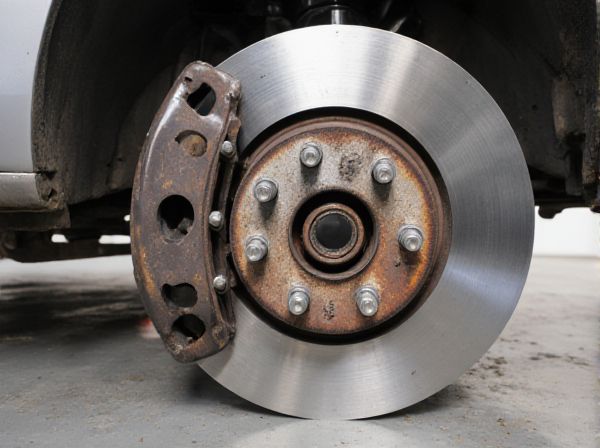
Photo illustration: One-piece Rotor vs Two-piece Rotor
One-piece rotors offer superior structural integrity and are less prone to warping under extreme heat, making them ideal for high-performance applications. Two-piece rotors provide better heat dissipation and easier replacement of the rotor surface, which can reduce maintenance costs over time. Choosing between them depends on Your vehicle's usage and whether you prioritize durability or cost-effective upkeep.
Table of Comparison
| Feature | One-piece Rotor | Two-piece Rotor |
|---|---|---|
| Design | Single solid metal piece | Aluminum hat with replaceable iron ring |
| Weight | Heavier | Lighter due to aluminum components |
| Heat Dissipation | Standard heat handling | Better heat dissipation with reduced warping |
| Durability | Less resistant to thermal stress | Higher resistance, longer lifespan |
| Maintenance | Full rotor replacement required | Only iron ring replaced, cost-effective |
| Cost | Lower initial cost | Higher initial cost, cheaper over time |
| Performance | Suitable for everyday use | Enhanced performance for high-stress driving |
Introduction to Brake Rotors
One-piece rotors consist of a single solid disc that combines the braking surface and the hub, offering simplicity and cost-effectiveness in brake systems. Two-piece rotors separate the braking surface from the central hub, typically joined by bolts or pins, providing enhanced heat dissipation and reduced rotor warping. The selection between one-piece and two-piece brake rotors significantly impacts vehicle performance, durability, and maintenance requirements.
What is a One-piece Rotor?
A one-piece rotor is a type of brake rotor manufactured from a single solid piece of metal, typically cast iron or steel, which provides structural integrity and improved heat dissipation. This design enhances braking performance by reducing the likelihood of warping under high temperatures during intense braking conditions. One-piece rotors are commonly used in everyday passenger vehicles due to their durability and cost-effectiveness compared to multi-piece rotors.
What is a Two-piece Rotor?
A two-piece rotor consists of a central hub and a separate braking surface, typically made from different materials to optimize performance and durability. This design reduces heat transfer to the hub, minimizing warping and improving overall brake efficiency compared to one-piece rotors. Two-piece rotors are commonly used in high-performance and racing vehicles due to their enhanced cooling capabilities and easier maintenance.
Key Differences Between One-piece and Two-piece Rotors
One-piece rotors integrate the braking surface and hub into a single unit, offering increased strength and simpler installation but potentially higher costs due to material use. Two-piece rotors consist of a separate braking ring and hub, allowing for easier replacement of worn components, improved heat dissipation, and often lighter weight configurations. The key differences center on serviceability, thermal management, weight, and cost efficiency in automotive braking systems.
Performance Comparison: Heat Dissipation and Cooling
One-piece rotors offer uniform heat dissipation due to their solid construction, but may retain heat longer during intense braking. Two-piece rotors typically feature an aluminum hat connected to a steel braking surface, enhancing cooling efficiency by allowing better heat expansion and reducing thermal deformation. This design improves overall performance by maintaining lower brake temperatures, which ensures consistent braking power and reduces the risk of brake fade under high-stress conditions.
Durability and Longevity
One-piece rotors typically offer enhanced durability due to their solid construction, reducing the risk of warping and providing consistent braking performance over time. Two-piece rotors, often composed of an aluminum hat and a separate steel braking surface, improve thermal dissipation and resist heat-related deformation, extending the lifespan under high-stress conditions. The choice between one-piece and two-piece rotors depends on balancing durability against heat management needs, with two-piece designs generally favored for performance and longevity in demanding driving scenarios.
Weight Considerations and Unsprung Mass
One-piece rotors typically weigh more than two-piece rotors, contributing to increased unsprung mass, which can negatively impact vehicle handling and suspension responsiveness. Two-piece rotors, often constructed with an aluminum hat and a separate iron braking surface, significantly reduce weight, thereby improving unsprung mass and enhancing overall driving dynamics. Reduced unsprung mass leads to better traction, improved ride quality, and decreased wear on suspension components.
Cost and Maintenance Factors
One-piece rotors generally have a lower initial cost and simpler maintenance due to fewer components and straightforward design, making them ideal for standard vehicle use. Two-piece rotors, featuring a separate rotor ring and hat, offer enhanced heat dissipation and reduce warp risk but come with higher costs and more complex maintenance requirements. Their modular construction often leads to easier replacement of worn rotor rings, potentially lowering long-term maintenance expenses despite the upfront investment.
Ideal Applications for Each Rotor Type
One-piece rotors are ideal for high-performance vehicles and daily drivers seeking durability and consistent braking performance under normal driving conditions. Two-piece rotors excel in racing and heavy-duty applications where heat dissipation and reduced unsprung weight are critical for enhanced braking efficiency and longevity. Selecting the appropriate rotor type depends on balancing cost, performance needs, and operating environment.
Choosing the Right Rotor: One-piece vs Two-piece
One-piece rotors offer simplicity and cost-effectiveness, ideal for standard driving conditions where ease of maintenance is key. Two-piece rotors provide superior heat dissipation and enhanced performance for high-stress applications like racing or heavy towing, reducing warp and extending rotor lifespan. Selecting the right rotor depends on driving style, vehicle use, and budget, with two-piece rotors favored for aggressive use and one-piece rotors suited for everyday commuting.
 caratoz.com
caratoz.com